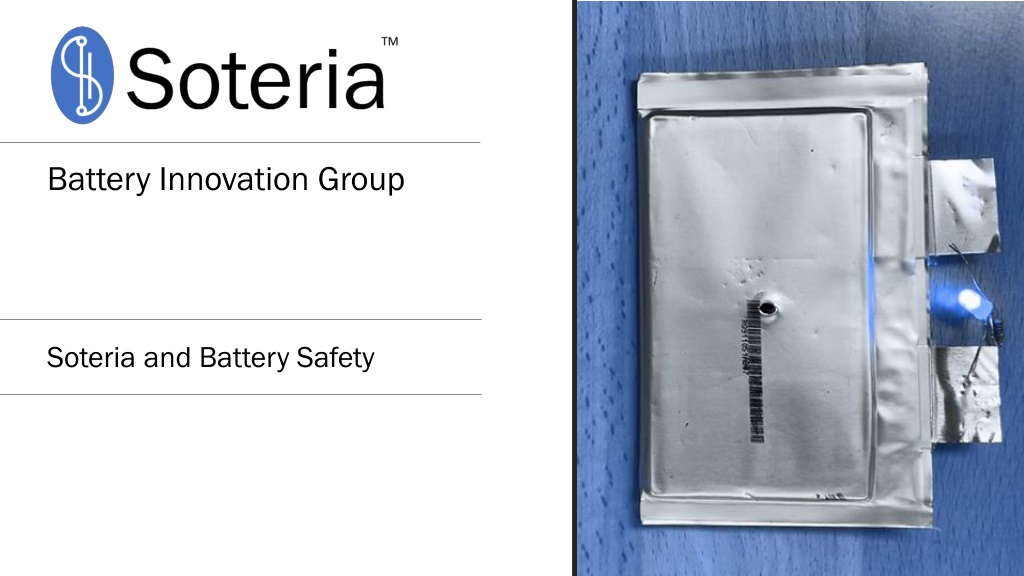Lithium-ion Battery Fire Risks and Safety Measures
Lithium-ion batteries pose significant fire hazards due to factors like flammable materials, manufacturing defects, and charging accidents. The frequent incidents of battery fires in various industries highlight the pressing need for improved safety measures. Current solutions, though existing, are heavy, costly, and insufficient in effectively protecting against fire risks and defects. Comprehensive efforts are necessary to enhance battery safety and prevent potentially catastrophic incidents.
Download Presentation

Please find below an Image/Link to download the presentation.
The content on the website is provided AS IS for your information and personal use only. It may not be sold, licensed, or shared on other websites without obtaining consent from the author. Download presentation by click this link. If you encounter any issues during the download, it is possible that the publisher has removed the file from their server.
E N D
Presentation Transcript
Battery Innovation Group Soteria and Battery Safety
Every Battery Fire Hurts 80 TON BATTERY FIRE IN CHICAGO 80 TON BATTERY FIRE IN CHICAGO SOME FIRE STATISTICS SOME FIRE STATISTICS Waste Management: 245 fires, $1.2 B/a Energy Storage: 28 fires in Korea Hybrid EVs: 3,474 fires per 100k sales (EV is lower, but they have not been on the road as long.) Air/airports: 350 fires Vapes: 2,035 fire injuries Consumer Products: 138 fire recalls E-bike: battery fires double in NYC Battery-related: 78,926 hospitalizations 2016 2020 in USA Confidential 3
Lithium-ion fires: a drumbeat of public events 2020 2020 2014 2014 2015 2015 2021 2021 2021 2021 Ford recalls 20,000 vehicles, stops production & US launch Boeing 787 Grounded ~$1 billion loss Amazon & Target stop selling hoverboards due to fires. Tesla S Plaid production stopped for battery fires. Chevrolet Bolt recall $2 billion 2014 2014 2020 2020 2016 2016 2021 2021 2022 2022 Tesla recall, adds titanium plate to all Model S, X BMW EV recall. 26,700 vehicles Samsung Galaxy Note 7 Recall. $17 billion lost revenue Hyundai Kona EV recall $900 million EV container ship sinks $440 million
How lithium-ion batteries catch fire Contain flammable materials Electrolytes Lithium metal Ignition caused by release of electrical energy Manufacturing defects Charging Accidents Physical damage Heat After an accident While charging Once put out, electrical energy can reignite batteries Average 30,000 gallons of water to put out EV fire, vs. 300 gallons for gasoline fire Driving While parked Pedaling Playing golf
How lithium-ion batteries catch fire Contain flammable materials Electrolytes Lithium metal Ignition caused by release of electrical energy Manufacturing defects Charging Accidents Physical damage Heat After an accident While charging Once put out, electrical energy can reignite batteries Average 30,000 gallons of water to put out EV fire, vs. 300 gallons for gasoline fire Driving While parked Pedaling Playing golf
Current solution is heavy, expensive and inadequate >30% weight and cost burden Steel / aluminum box Titanium plates Spacers / dividers Sensors Fuses / switches Fires still occur Current solution does not protect Current solution does not protect against defects against defects Inadequate protection against physical damage Vehicle Battery Pack
But today, demand is outstripping supply Confidential 8
Gigafactories: 250 GWh or 0.25 TWh ~7 Tesla Gigafactories 200-mile range: 3 hrs of driving time 200,000 mile battery 60 kWh battery: 400 kg Today s Electric Vehicle Today s Electric Vehicle 3% of car industry 50% of battery industry 100 300-mile range 40 100 kWh battery $40 120,000 1 8h charge Safety Spontaneous fires Damage induced fires $40 100,000: Total cost of ownership ~200% of ICE 1h charge: 250 kW Safety: some spontaneous fires many/most collisions fire Confidential
Todays Electric Vehicle Today s Electric Vehicle 3% of car industry 50% of battery industry 100 300-mile range 40 100 kWh battery $40 120,000 1 8h charge Safety Spontaneous fires Damage induced fires Tomorrow s Electric Vehicle Tomorrow s Electric Vehicle 80% of car industry 75% of battery industry 600-mile range 200 kWh battery $20 50,000 0.5h charge Safety no fire after 75 mph collision Confidential
Gigafactories: 16,000 GWh or 16 TWh ~400 Tesla Gigafactories 600-mile range: 8 10 hrs of driving time 1.2-million-mile battery 200 kWh battery: today 1,000 kg tomorrow < 500 kg Tomorrow s Electric Vehicle Tomorrow s Electric Vehicle 80% of car industry 75% of battery industry 600-mile range 200 kWh battery $20 50,000 0.5h charge Safety no fire after 75 mph collision $20 50,000: Total cost of ownership ~50% of ICE 0.5h charge: 400 kW, about 3x today s fast charge Safety: no fire after 75 mph collision Today some spontaneous fires most collisions fire Confidential 11
Reflections NEAR FUTURE OF EVS NEAR FUTURE OF EVS DISTANT FUTURE OF EVS DISTANT FUTURE OF EVS Everything changes Cars drive you for 600 miles without charging Charging in every parking lot along travel lanes Travel is no longer an inconvenience because mobile office, work-from-car Auto becomes competitive with air Cost per mile traveled goes down but EV prices remain high for a long time Supply limited market keeps prices high EVs will remain premium product Old guard will fight a rear retreat EV sales will not make up for lost market share of ICE New entrants will succeed Electric point-to-point air is real Drone delivery is real Rivian, Lucid, Nio, Li Auto Once-a-century opportunity for premium brands Drivers rarely needed in air, cargo, personal transport Confidential 12































